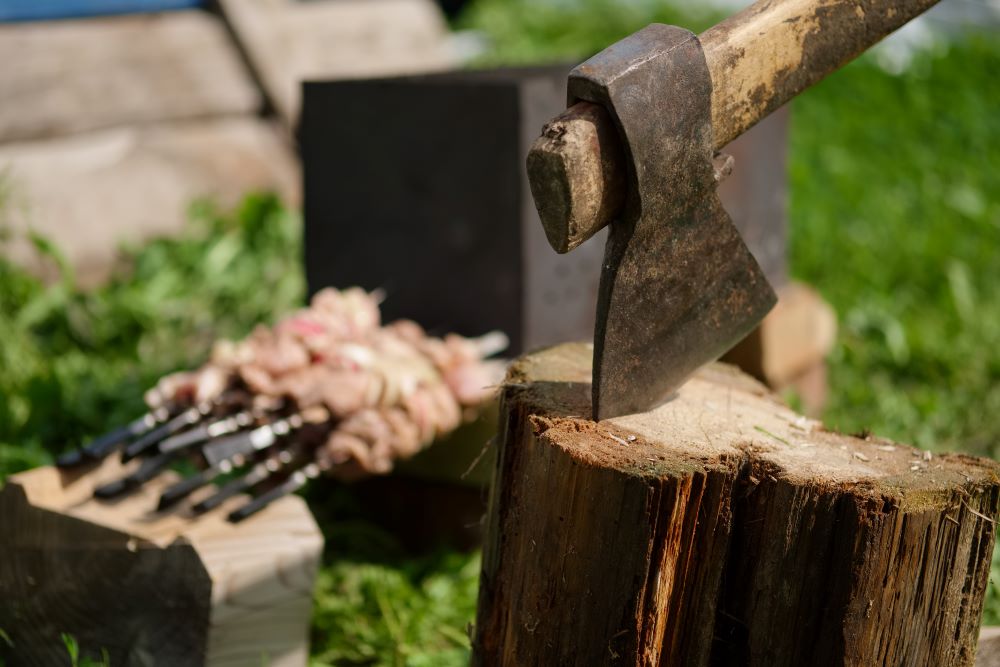Axe-Throwing Games and Challenges for Team Building Success
In the ever-evolving landscape of corporate team building, innovative and engaging activities are constantly sought after to break the monotony of conventional exercises. One such activity that has gained immense popularity is axe-throwing – a thrilling and unique experience that combines physical skill with strategy and teamwork. This blog explores how axe-throwing games and challenges can be effectively utilized for team building success.

The Rise of Axe-Throwing
Axe-throwing, historically rooted in lumberjack traditions, has been transformed into a modern sport, offering a unique blend of physical activity and entertainment. Its rise in popularity can be attributed to its simplicity and the exhilarating experience of mastering a new skill. The game’s basic premise – throwing an axe at a target – is simple enough for beginners, yet challenging enough to keep participants engaged and motivated. Axe-throwing’s appeal also lies in its ability to provide a raw and primal experience, a contrast to the digital and automated world we live in. This engaging activity not only allows individuals to connect with a bygone era of craftsmanship and outdoor survival skills but also offers a refreshing and invigorating break from the routine of modern life, making it a perfect team-building exercise.
Why Axe-Throwing for Team Building?
Encourages Healthy Competition
Axe-throwing naturally fosters a competitive environment, but it’s a competition that’s rooted in fun and personal challenge. It pushes individuals to improve their skills, while also cheering on their teammates. This balance of individual and team effort makes it an ideal platform for encouraging a positive competitive spirit without fostering undue stress or rivalry. Moreover, the thrill of hitting the target provides a sense of accomplishment, which is key to boosting self-confidence and team morale.
Enhances Communication Skills
Teams must communicate effectively to strategize and support each other, which is a key component of successful teamwork in any business setting. In axe-throwing, clear communication is crucial for safety and success, teaching participants to convey their ideas and listen to others effectively. This activity also allows team members to develop non-verbal communication skills, as they learn to read body language and understand cues during gameplay.
Builds Trust and Camaraderie
Trust is built when team members encourage and rely on each other. This shared experience of learning and enjoying a new activity can strengthen bonds between colleagues. As team members step out of their comfort zones together, it creates a shared sense of vulnerability and growth, which is fundamental in building deeper, more meaningful relationships. Celebrating each other’s successes and providing support during challenges in the game reflects how team members can cooperate in a work setting.
Relieves Stress
The physical act of throwing an axe can be a great stress reliever. It provides a break from the usual work environment and allows employees to engage in a fun, high-energy activity.
Setting Up an Axe-Throwing Event
Choosing the Right Venue: Opt for a reputable axe-throwing facility that prioritizes safety and provides trained staff to guide your team.
- Safety Briefing: Before starting, it’s crucial to have a safety briefing. Every participant should understand the safety protocols to ensure a safe and enjoyable experience. This briefing should cover the proper handling of axes, the correct way to throw, and the importance of maintaining a safe distance from the target area while others are throwing. It’s also essential to review emergency procedures and the location of first aid kits, should any accidents occur. Emphasizing these safety measures not only minimizes the risk of injury but also helps to create a more relaxed and confident environment for all participants.
- Equipment and Training: Quality axes and proper training are essential. Participants should be instructed on how to handle and throw the axe correctly to prevent injuries and maximize enjoyment.
Games and Challenges
Standard Target Challenge
This is the basic form of axe-throwing, where individuals aim for a target and score points based on accuracy. It’s great for beginners to get a feel for the sport. In this challenge, the target is usually marked with concentric circles, each having different point values, challenging throwers to be as precise as possible. This not only helps in honing throwing skills but also in understanding the importance of focus and steadiness. The standard target challenge is perfect for fostering a healthy competitive spirit while allowing individual progress tracking.
Team Relay
Teams take turns throwing axes, with each throw contributing to the team’s total score. This encourages teamwork and strategy. In a team relay, coordination and planning are key, as team members decide the order of throwers and the best approach to accumulate points. It’s an excellent way to encourage communication within teams, as members often discuss and adjust strategies based on the performance of their teammates. The relay format also ensures that all team members are engaged and invested in the team’s overall success.
Blindfold Challenge
Participants take turns throwing under the guidance of a teammate’s instructions, emphasizing trust and communication. In this challenge, the blindfolded thrower relies entirely on their partner’s directions for aiming and timing, which can be both challenging and hilarious. It’s a fantastic exercise for building trust, as the thrower must rely on their teammate’s guidance, and for enhancing communication skills, as directions need to be clear and concise. This challenge also adds an element of fun and unpredictability, often leading to memorable moments and laughter.
Timed Challenges
Teams compete to hit the most targets within a set time frame, fostering a sense of urgency and collaboration. This challenge demands quick thinking and rapid decision-making, as teams strive to score as many points as possible within the limited time. It encourages participants to work under pressure, simulating tight deadlines common in many workplace scenarios. Timed challenges are also great for building team spirit, as members cheer each other on and celebrate each successful hit, creating an energetic and supportive atmosphere.
Integrating Axe-Throwing into Your Team Building Strategy
When planning an axe-throwing team-building exercise, it’s crucial to set clear objectives, understanding whether the goal is to improve communication, build trust, or simply provide a fun and engaging outlet for the team. Following the event, a debriefing session is essential, where participants can reflect on what they learned from the experience and discuss how these insights can be applied in the workplace to enhance teamwork and productivity. Ensuring inclusivity is also key; while axe-throwing is an activity that can be enjoyed by people of various physical abilities, it’s important to consider and accommodate everyone’s comfort level and participation preferences. This approach not only ensures that all team members feel valued and included but also maximizes the overall effectiveness of the team-building exercise. Through thoughtful planning and reflection, axe-throwing can become a powerful tool for fostering a stronger, more cohesive team.
Safety First
Safety is paramount in axe-throwing. It’s essential to choose venues with stringent safety standards and experienced staff. Participants should always follow the guidelines provided and use the equipment as instructed. Additionally, participants should be aware of their surroundings at all times, especially being mindful of other throwers and maintaining a safe distance. Regular equipment checks by the staff for any signs of wear or damage also play a crucial role in ensuring a safe environment for everyone involved.

Making Axe-Throwing an Unforgettable Experience
- Personalized Challenges: To make the event more memorable, incorporate personalized challenges or themes that resonate with your team or company culture. For instance, setting up targets with different business goals or project names can add a layer of relevance and fun.
- Awards and Recognitions: Recognize individual and team achievements with awards or certificates. Categories like ‘Best Throw’, ‘Most Improved’, and ‘Team Spirit’ not only celebrate success but also boost morale.
Photography and Videography: Capture the moments! Hiring a photographer or setting up a photo booth can make the experience memorable. These photos and videos can be shared later, serving as a reminder of the fun and lessons learned.
The Psychological Benefits of Axe-Throwing
Engaging in physical activities like axe-throwing has several psychological benefits. It releases endorphins, the body’s natural mood lifters, which can lead to increased morale and a sense of well-being. Furthermore, the concentration required in axe-throwing can serve as a form of mindfulness, helping participants to focus on the present moment and temporarily set aside work-related stress.
Team Dynamics and Learning Outcomes
Axe-throwing can reveal a lot about team dynamics. It brings out natural leaders, encourages those who are more reserved, and showcases how individuals handle pressure. Reflecting on these dynamics post-event can provide valuable insights into how team members can best collaborate in the workplace.
Beyond the Axe-Throwing Event: Continuity in the Workplace
The benefits of an axe-throwing event can extend into the workplace. Leaders can draw parallels between the skills used in axe-throwing – such as focus, precision, and patience – and those needed in the workplace. Regular team-building activities, not necessarily axe-throwing every time, can maintain the momentum and keep the team spirit alive.
Including Everyone: Alternatives for Diverse Axe-Throwing Teams
Recognize that not everyone may be able to participate in axe-throwing. Have alternative activities available so everyone feels included. Activities like target painting or cheering squads can keep everyone engaged and part of the team experience.
Tailoring the Experience to Your Team
Understand your team’s unique dynamics and interests to tailor the experience. Some teams might enjoy a highly competitive environment, while others might prefer a more casual, collaborative approach. The key is to align the activity with your team’s culture and goals.
Feedback and Continuous Improvement
After the event, gather feedback to understand what worked and what didn’t. This feedback is crucial for planning future team-building activities that are even more aligned with your team’s needs and preferences.
Learn More About Axe-Throwing Games Today
Axe-throwing is more than just an exciting activity; it’s a potent tool for team building. It provides a unique opportunity for employees to step out of their comfort zones, engage in healthy competition, and foster stronger bonds. By incorporating axe-throwing into your team-building strategy, you can create an unforgettable experience that not only entertains but also contributes to the overall success and cohesion of your team.
Check out our Propel Axe blog to learn more about our events and services for customers in Arvada, CO.


 720-330-9755
720-330-9755
